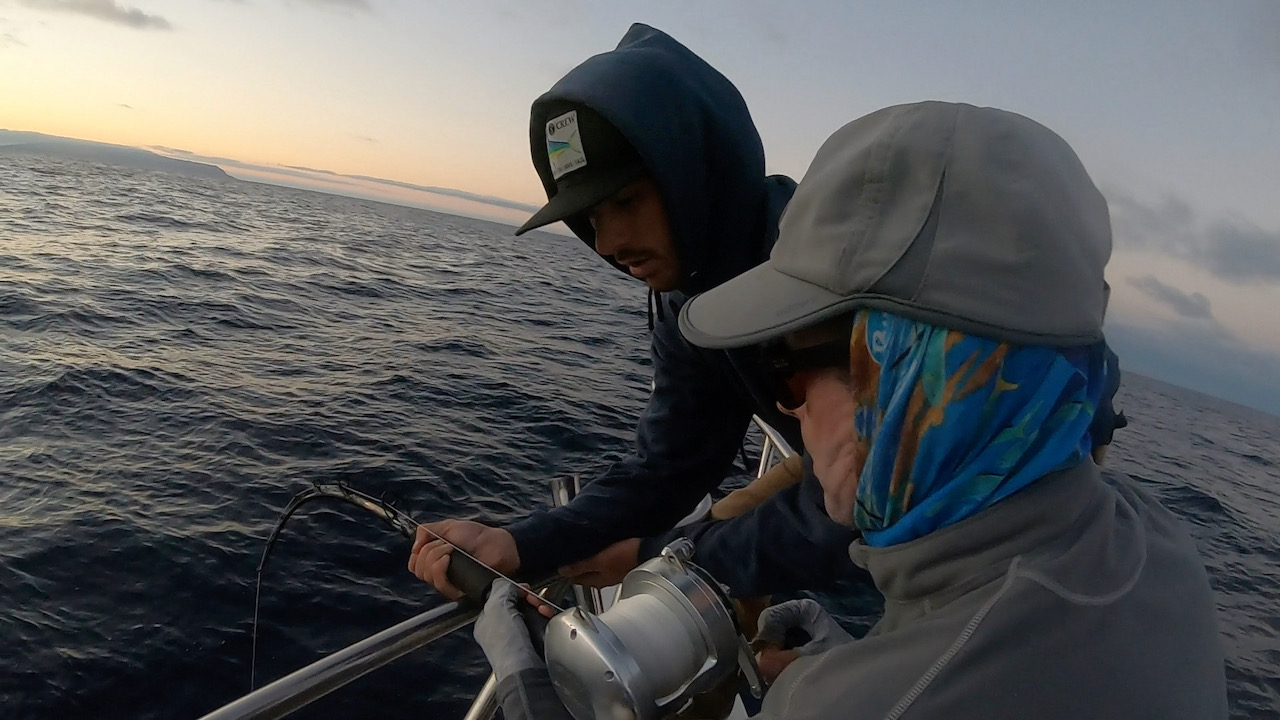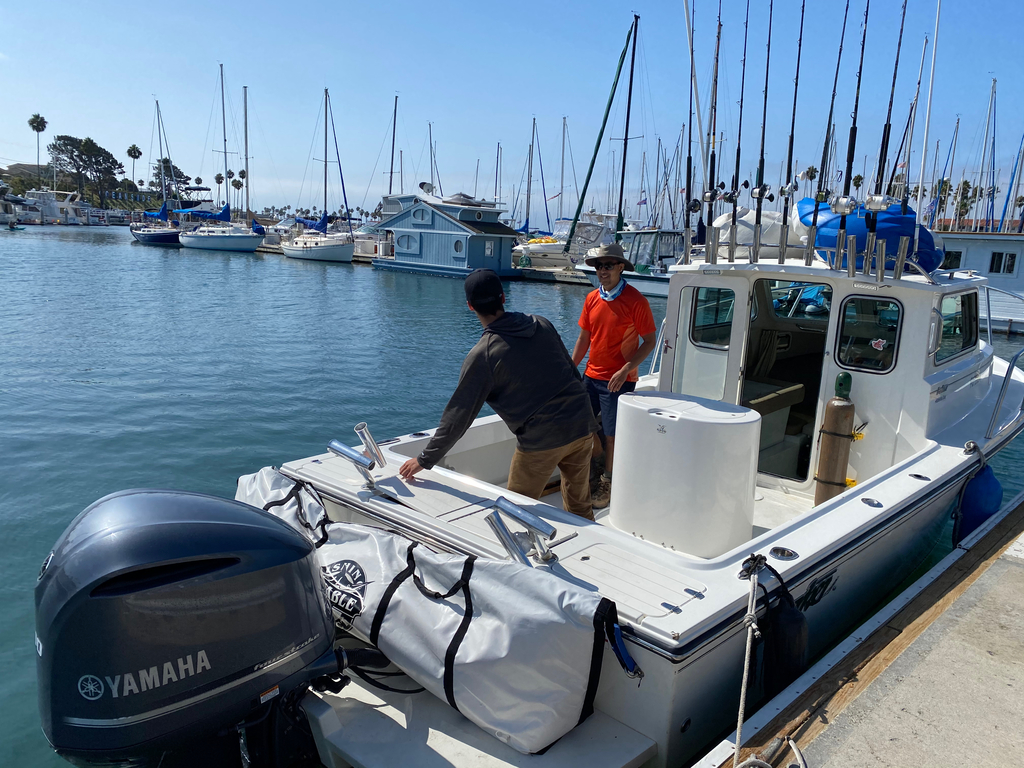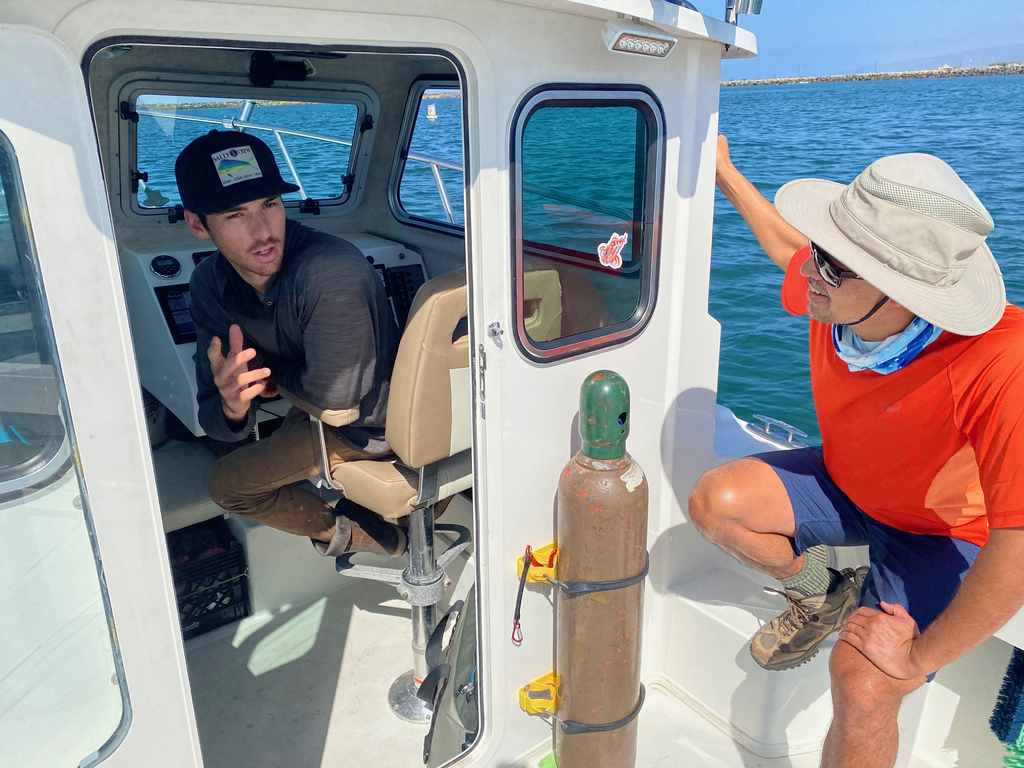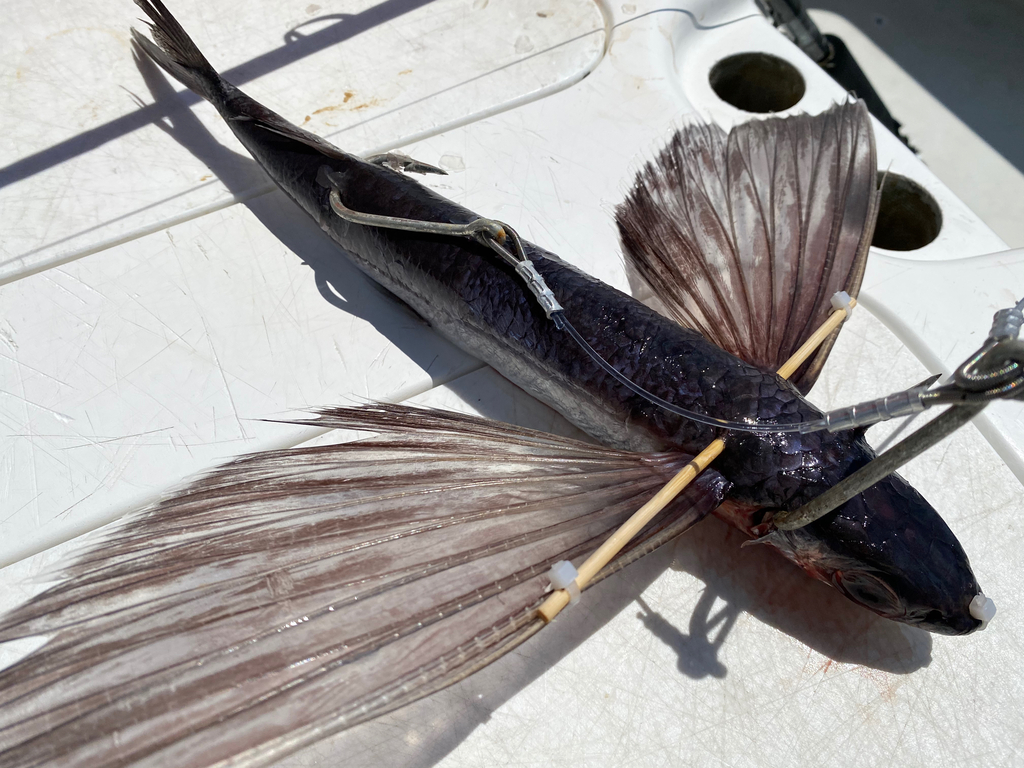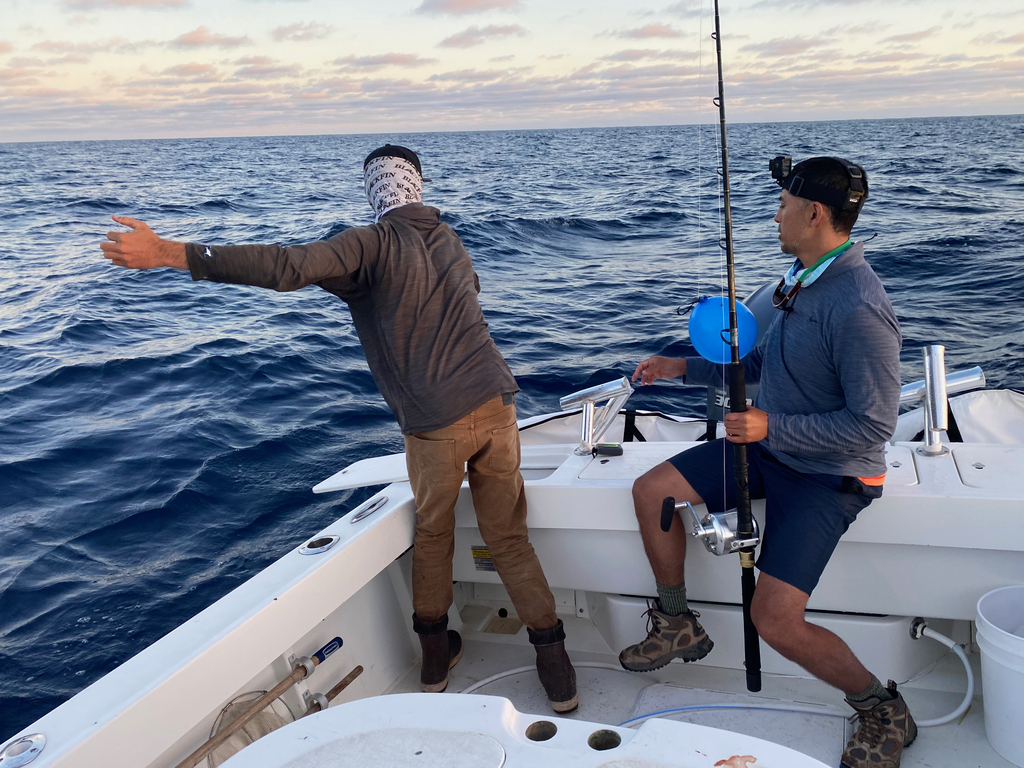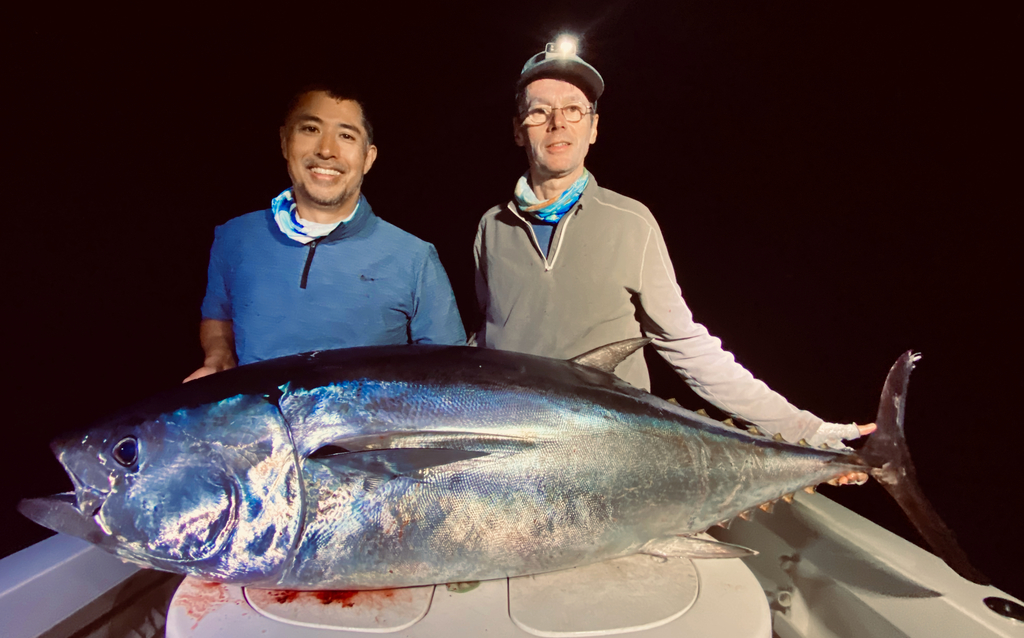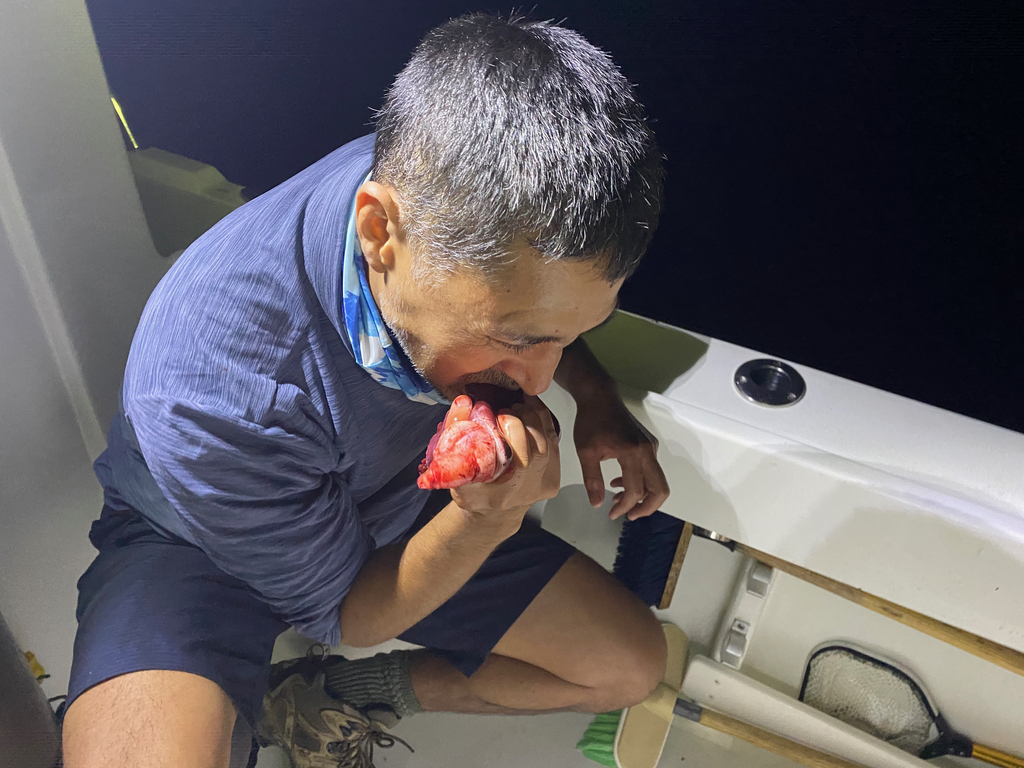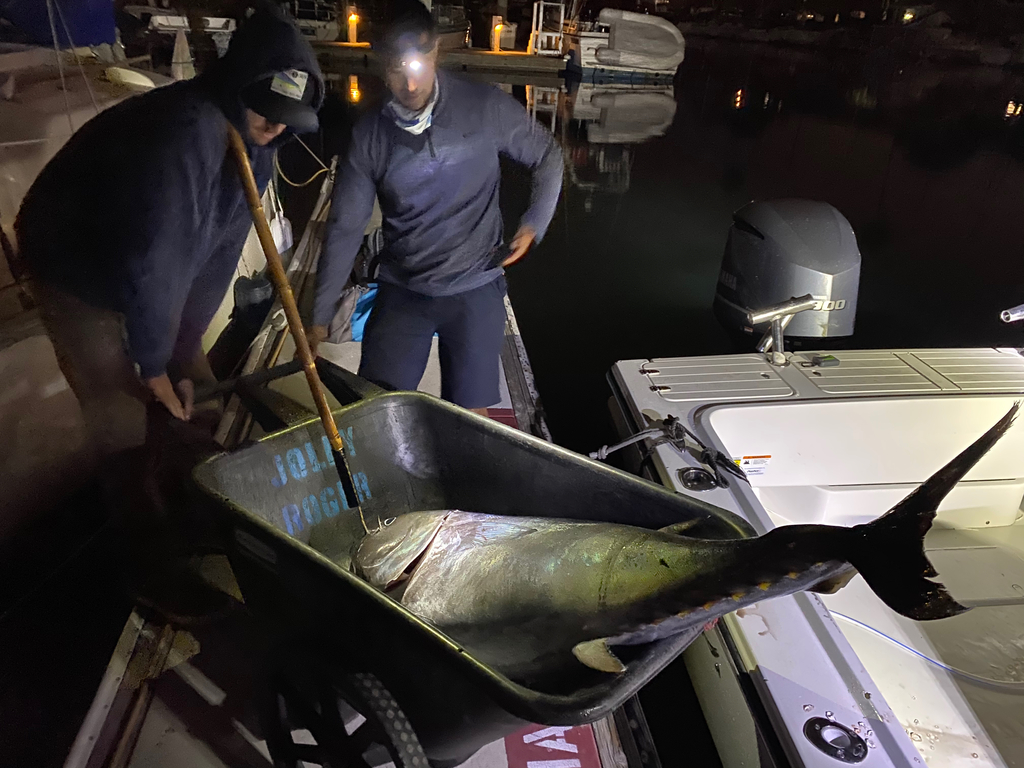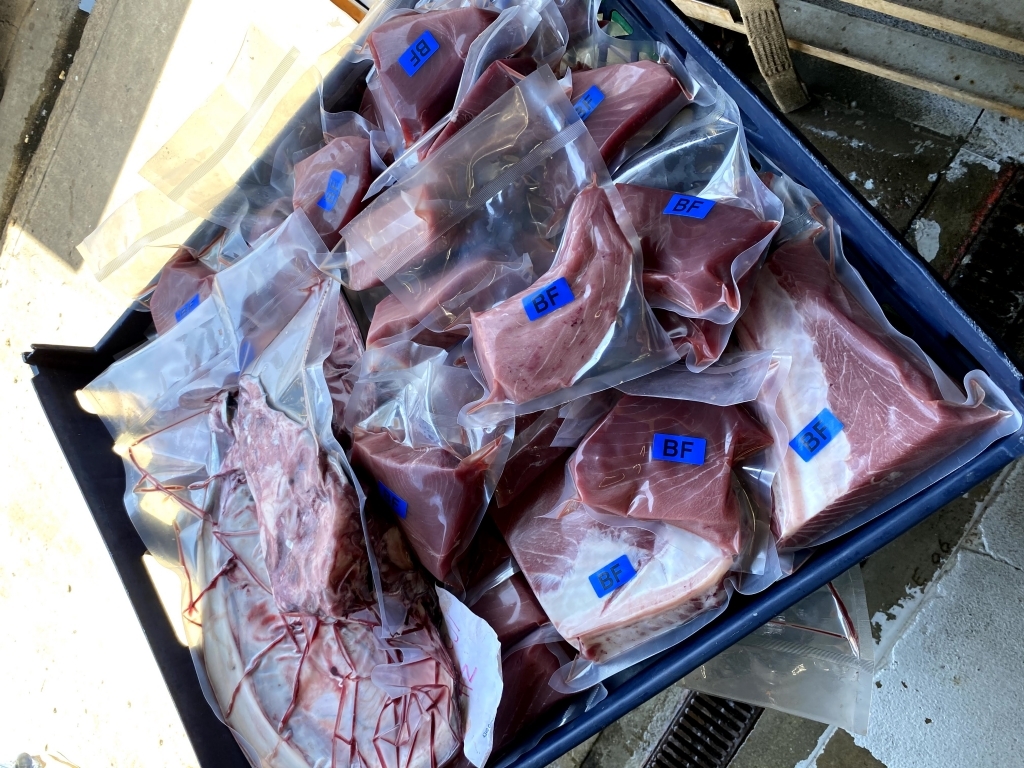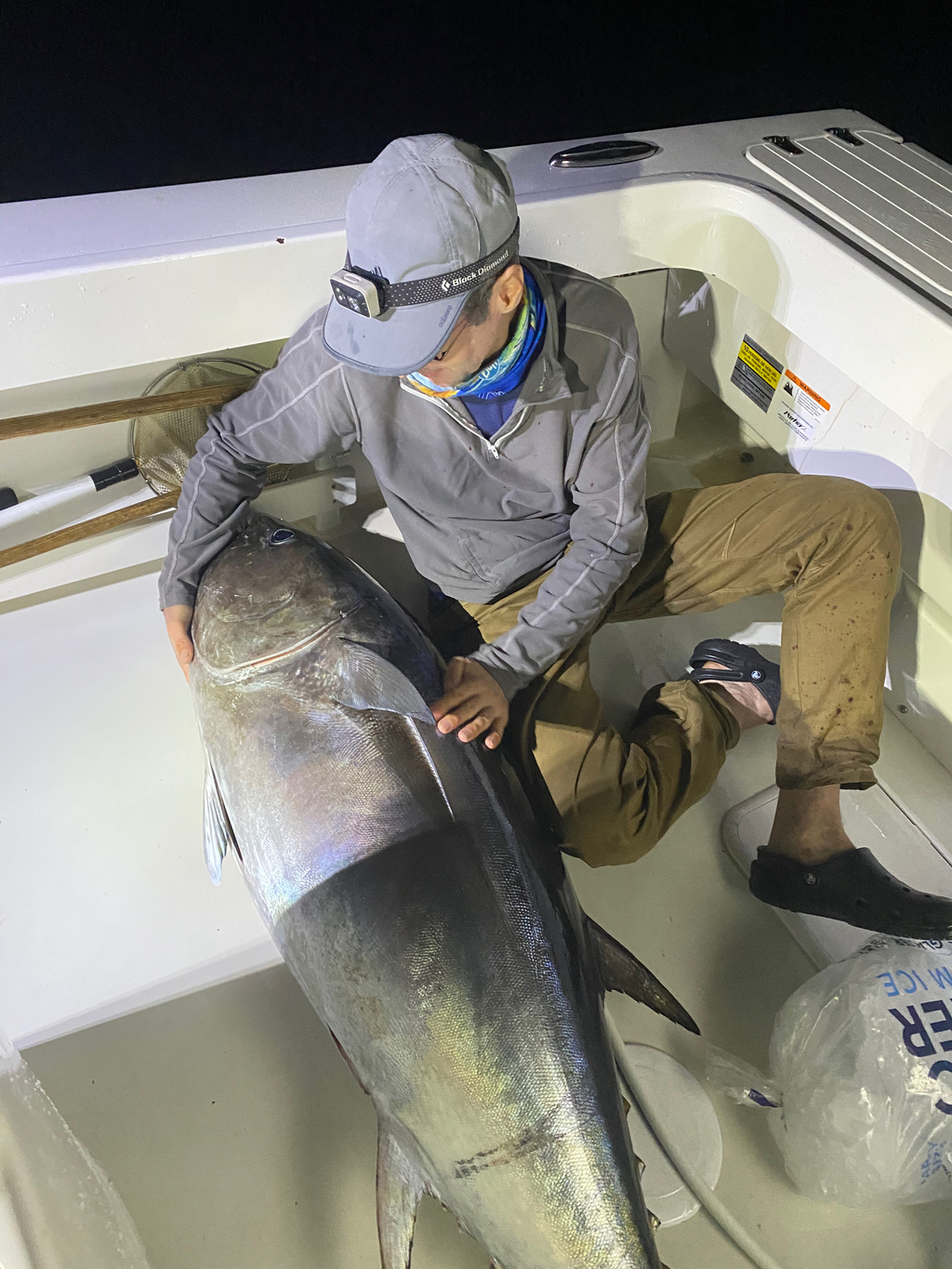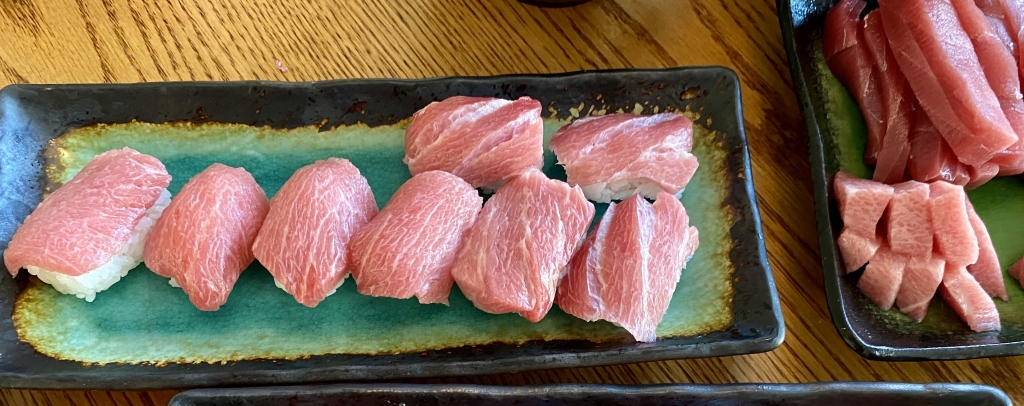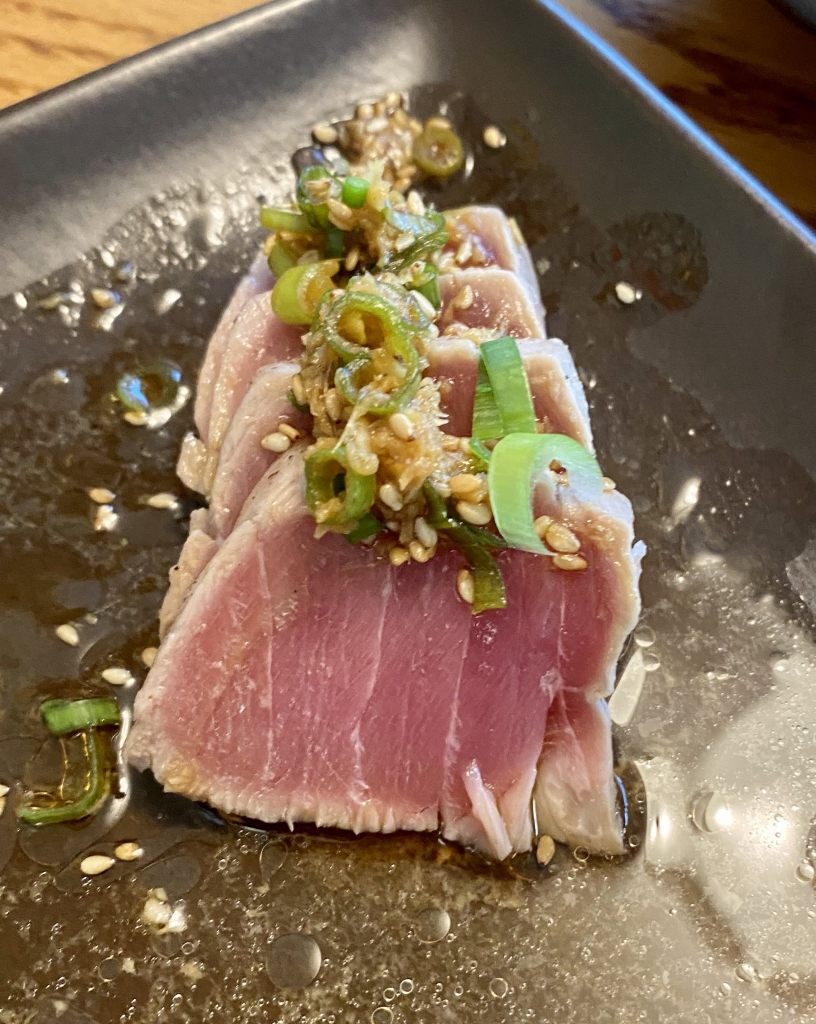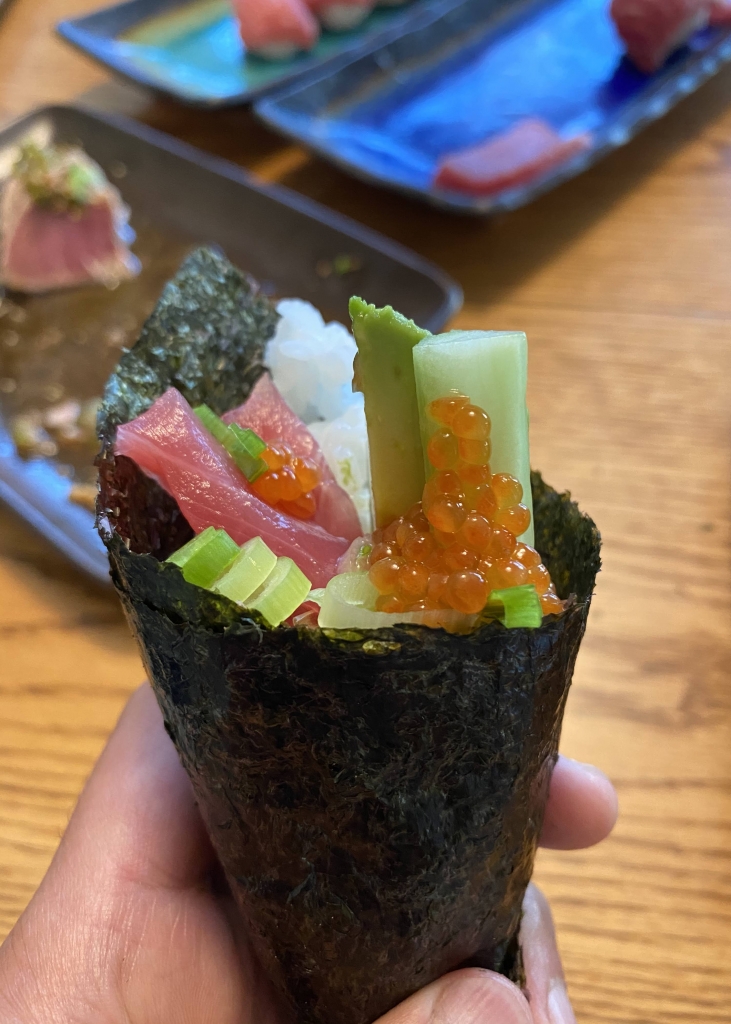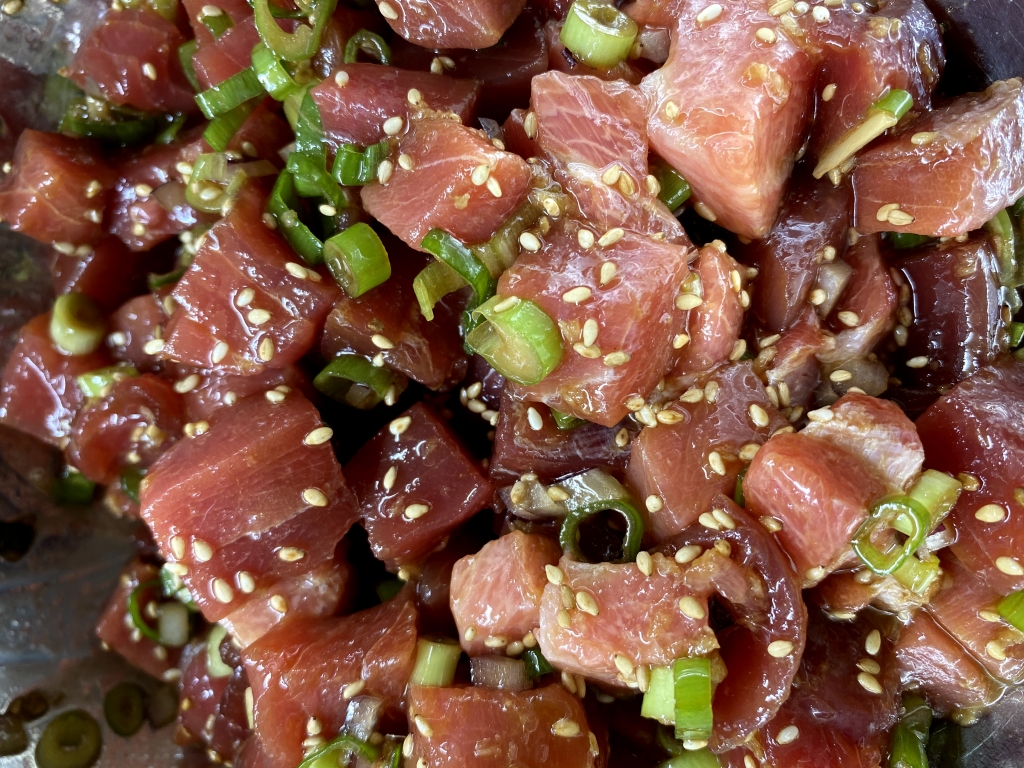Koji and I combined to nail a big bluefin tuna on an offshore trip; or was is the other way around?
Posted on August 31, 2020
I had circled the date on my calendar long in advance. August 31 would be Bluefin Monday. The whole idea started when Koji approached me about an offshore trip from San Diego in SoCal, and it began to manifest itself more and more in my thoughts as the date approached. This was an expensive trip, completely out of the realm of what I typically do in fishing, and I wanted to will it to be successful. It was a once in a lifetime chance to catch the king of fish, the most precious of them all, a true trophy, the mighty Bluefin Tuna.
Below is the full account we originally published on NorCal Kayak Anglers (NCKA). The first part was written by Koji, the second by yours truly. On NCKA we use screen names, Koji is Sakana Seeker, mine is, well, you'll guess it...
PART I - How we went deep into overtime to nail a big Pacific Bluefin Tuna
Intro: Even when I was hooked onto a 6’ thresher shark on light tackle, I’ve always felt in control of the situation. Hooking a bluefin tuna off the coast of San Diego was like being attached to a running rhinoceros. The 180-pound braid was so tight that it would twang like a guitar string and even with the drag set at some ridiculous poundage, line would easily peel off and it was obvious who was in control…
Full TR: The big bluefin are back in San Diego. Over a century ago, the famous Tuna Club of Avalon, Santa Catalina Island, was founded by Charles F. Holder after his historic rod and reel catch of a 183-pound bluefin tuna (BFT) in 1898. Many notable dignitaries have come and gone through their doors and importantly, club members have recorded each catch since 1900. Bluefin peaked in 1923 then crashed to zero in 1932-1933. These waters have not seen a significant return of BFT for the last 100 years, until recently, as warming waters off the San Diego coast have brought back big bluefin of 100, 200, even 300+ pounds.
A good friend of mine went on a long-range trip last year and had an incredible time, catching limits of YFT and BFT. I was planning to join him on the same 5-day charter in October this year but then the pandemic hit and sleeping in tight quarters with strangers just didn’t seem like a good idea to me. But the thoughts of big BFT kept swimming through my mind. What would it be like to hook one of these amazing creatures? How good would the maguro be? One night early this summer, as I stayed awake reading about tuna fishing, I came across two 4-pack operators: Duane Diego at Pinnacle Sportfishing and Brandon Hayward at Bight Sportfishing. Both offered single day charters for big BFT with very limited loads of 1 to 4 people. Could this be a way to safely socially distance on the water and go after BFT despite the pandemic?
I contacted Brandon Hayward at Bight the next morning to learn more. Easy going and full of optimism, Brandon told me about their 23’ Parker that we could charter out of Oceanside. For the big BFT, we would fish the kite on a full day trip, leaving in the morning and coming home in the dark. Everything would be outside, and we could charter the boat for 2 people. I called my long-time fishing partner Plankton to see if he was interested, and before I could even deliver my pitch, he was in! Originally, I had zeroed in on 9/20 for no particular reason, but then changed our booking to 8/31 because it was the day before the full moon. Reading up on this, there are mixed opinions about the relationship between the tuna bite and the lunar calendar. The idea is that they come up to the surface to feed during full moons because they can see the bait from deep below. Like other superstitious elements around fishing, some swear by it while others scoff. Brandon was also understandably ambivalent, saying something to the effect of “we’ve caught them on the full moon for sure. We’ve also had incredible days without the full moon. You wanna book the 31st? It might be good”.
June and July were wide open and big 150+ pound tuna were reported daily. However, the bite disappeared in August and as the weeks dragged on in silence, I became nervous about our trip. There were literally zero reports. Brandon was excellent with the communication and reassured us that they would do everything they can to give us an opportunity. Of course, it’s fishing and there are no guarantees, but I was relieved to know that this was not a “take your money and run” kind of operation. They wanted to get on the fish as much as we did! Finally, in late August after weeks of nothing, came the first positive signs from a multi day trip. Soon after, Brandon sent me an email: “It busted open. They’re back”.
I could hardly sleep on the nights leading up to our trip, but the day finally arrived. Brandon owns the company, and besides himself, he has two other captains (Captains Jake and Wes) running the show. We met Captain Jake in the morning at Oceanside Harbor. This young man looks just a handful of birthdays older than my 6th grader, but he is a legend in SoCal fishing circles having grown up on boats and guiding. He was courteous, professional, and brimming with youthful energy. Within minutes, we were onboard and listening to the smooth purr of the 300hp Yamaha pushing a brand new 23’ Parker as we made the 2-hour journey to the fishing grounds.
However, before we could get there, Jake cut the engine and the boat came to an abrupt halt. Whipping out of the cabin and leaping on top with binoculars in hand, he started to scan the horizon, speaking while moving that he thought he saw something, even though we were 10-15 miles short of where he originally intended to be. We would soon come to learn that we were in the hands of one of the fishiest human beings on the planet. From a lifetime on the water, Jake has developed a keen sense of reading the surface and understanding how all of the elements around us are moving together. Sure enough, some distance away in the direction of his binoculars, a huge foamer at least 200 yards wide erupted on the surface. Plankton and I had never seen anything like this – what looked like white caps in a concentrated area were bluefin tuna feeding and thrashing at the bait on the surface! Jake dove back in the seat and gunned the boat to get us within striking distance.
Once in range, we still had to set up the kite, balloon, and frozen flying fish. This method of fishing was completely foreign to Plankton and me and involved a lot of moving parts and teamwork. Since tuna are quite shy, you need to present the bait far away from the boat. The captain puts the boat upwind of the fish. The main line is attached to the kite line, and the kite is flown away from the boat, downwind, hopefully taking your bait in the direction of the school. At the end of the mainline is a frozen flying fish, rigged with the wings open and hooks in its back. From underneath, none of the hardware on the bait is observable. One person mans the kite and the other mans the fishing rod. Both lines need to be fed out smoothly and at constant rates, ensuring that the bait just skims the surface of the water. If the timing is wrong and one line is faster than the other, the bait comes out of the water, or it gets dragged and flips upside down. Either way, the fish won’t bite. It was tricky at first, but we got the hang of it after a few tries.
Unfortunately, by the time we were set up, the fish had descended and the foamer was gone, but Jake suggested we put the bait out anyway for a practice run. After a couple of mishaps, we got the kite to successfully take our bait downwind, and all was quiet watching it 50 yards or so away from the boat. After a few minutes of watching, there was a sudden explosion under the bait, kind of like what you see with those water canons at the water-slide park. There was a spray of water that was ejected from underneath the bait. Jake yelled loudly “OHHH!!! YOU’RE BIT!” But nothing else happened. We just experienced our first drive-by. The fish had exploded on the bait, likely bashing it with it’s nose or tail, but did not commit and swallow it. Looking through the binoculars, Jake yelled, “OHHH that was a HUUUGE one!”. We reeled both lines in to discover a flying fish with a mangled wing and snapped back.
We would repeat this over the next few hours. Although we were not where Jake initially wanted to be, he had us on the fish constantly in this newly discovered area. He would see breezers, which are subtle disturbances on the surface of the water caused by schools of large fish underneath, several hundred yards away, circle the boat upwind and have us fly the bait in. I tried looking for these breezers too and could almost fool myself into believing I was seeing something. But no. He would also mark schools on sonar 70’ -150’ deep and get ahead of the school so that we could fly the bait on top of them. We experienced 4 or 5 drive byes, each occurring just minutes after skimming the bait into the strike zone. Again, Jake was extremely fishy, having an unreal sense of where we were in relation to the wind, current, and schools of fish. If the bait wasn’t hit, Jake was quick to get us back in position and more times than not, the bait would get hit on the second try. Unfortunately, we had not experienced a bite yet, and the drive-byes just resulted in mangled baits which had to be replaced, which took time.
Jake had mentioned that most of the time the fishing doesn’t really start until the evening, and the day before they had gotten the first of their 4 (FOUR!) big cows at 5pm. Sure enough, around 4:30pm, we got our first taker. The indicator balloon, our “bobber”, dove underwater and Jake screamed, “YOU’RE BIT!!! REEL!!! REEL!!! REEL!!!”. Chaos. Just absolute chaos as we both reel – me on the kite and Plankton on the fish. We get the lines in and the fish comes on – “I GOT IT! IT’S ON!”, yells Plankton as the line goes tight. Jake is right there, making sure that the main line comes off the kite line and we get that stowed away so it won’t tangle. Now the fight is on and Plankton is on the reel. It’s clear that this is not an ordinary fish as it is taking everything he has to stabilize himself while holding onto the rod, and Jake is yelling to wind – “Don’t stop winding!!”. Plankton is doing a good job, reeling in line when he can, but it looks difficult. I wonder if it’s really that hard. I soon get my chance to find out as Plankton asks me take the reel so that he can rest for a bit. As the rod comes into my hands, I instantly understand the predicament. The thing on the other end of the rod is HEAVY. If I didn’t know better, we were snagged on the bottom but we are in 4200 FOW. The drag is set tight. Probably 25 pounds or more. It could’ve been a thousand pounds, it was so foreign to have a fish on like this. The rod was short, maybe 5 feet, and stout like an unbendable rod of carbon. Yet Jake is imploring me to reel and get the line tight to put a bend in the rod. It feels like an impossible task. After a minute, my arms are tired, my hands are shaking, I can’t steady myself against the rocking boat, I can’t stabilize the 3-speed Avet which is the size of a cantaloupe, and this beast of a fish is in full control of the situation. I hand it back to Plankton who fights it for a few minutes and it was back in my hands again. Jake again warns us that we need more pressure on the fish and that it was not struggling yet. I, on the other hand, was full on struggling. At one point, the fish did a classic head shake and the line bounced. At the same time, the butt of the rod was digging into my left rib and I went to adjust. Just one second of slack. The rod straightens, Jake yells to reel, but it was already done. The fish felt its escape and it was gone.
Although Plankton and I didn’t talk about it then, we were both feeling the same thing. How in the hell are we going to reel in a fish like that? The fight was brutal and it only lasted 15 minutes at the most. I felt completely dominated. For the next hour or so, we fished in silence for a bit, both of us realizing that maybe this was not going to be the way we both had imagined. The hour ticked by. There was an amazing sunset developing, and my mind went to the place where all skunks go, “well, at least its an incredible view”. The sun was setting and there were beams of light coming through the clouds. It was beautiful.
On my last turn on the reel, probably around 7:00pm, I had spaced out and bird nested the line. I did my best to get it all straightened out, but knew there was one loose loop deep on the reel. As I handed it back to Plankton for probably the last time, Jake put a fresh bait on with a different rig – two large siwash hooks instead of the treble stinger we had been fishing for the last couple hours, including the only fish we had on. I said to Jake and Plankton, “hey, can we send the bait out as far as we need to so that we can get that loop out of the line? I’m sorry, it was my mistake”. Of course, having a loop like that could snap the line if we had a fish on and it was the right thing to do, but not ideal since we may end up overshooting the fish.
We watch the line go out, the bait is really far away. No sooner, and I mean literally as soon as Plankton says, “oh, I think that’s it, the loop is gone”, the bait is bit! Explosion on the water! But the bobber doesn’t go down. We wait a minute…nothing. We are all a little dejected. Finally, Jake makes the call, “Okay, bring it in. But bring it in slow, make sure you skip it in”. We all know we may not get another chance. It’s almost dark. As we bring it in slow, making sure that the flying fish is skimming the surface, all of a sudden the bobber gets pulled fast and deep in the water. “OHHHH YOU’RE ON!!!!” Yells Jake. Holy SH*T. In a state of disbelief, but somewhat more on autopilot having experienced this hours before, we put everything in motion. Plankton reeling the line to get it tight, me reeling the ballon, and waiting for Jake’s orders. We get the balloon squared away, Plankton gets the line tight, and the fight is on again!!
We take turns, reeling and fighting for 5-10 minutes a piece. The sensation is the same: an extremely heavy fish, very difficult to turn the reel, HEAVY. But, with just a teeny bit more confidence that we’ve been here before. Also a chip on the shoulder, we aren’t going to lose this one! We keep fighting. It’s getting darker, but we are still on. Probably 40 minutes now we’ve been taking turns. But we are doing well, putting a bend in the rod, fighting it on the rail. Finding some cadence with the swell of the boat, pulling line as the boat rocks towards the fish, and applying pressure as the boat rocks back. It’s a tug of war. After we use the boat to gain a bit of line, the fish takes a little back. We get the line tight and it repeats – pressure, the fish pulls a few inches, we get a few inches back. It’s brutal. And Jake is right there, helping each step of the way, but also teasing us and encouraging us at the same time, “come on, you got this!”, and “come on guys, I’m not doing this for you, this is your fish”, or “come on, use your mus-i-cles!”.
At one point, I almost gave up. I was having a hard time. But Jake said something, and I don’t know what led up to it, but he said, “this one has made in Japan stamped on it”. I don’t know why, but that gave me a surge of strength. I was going to land this maguro like my forefathers! I just kept reeling even though I couldn’t feel my arms. It was pitch dark now. Plankton shined a headlamp on the surface. All of a sudden, Jake is calling for the gaffs, he and Plankton see it at the surface. Jake is yelling directions at me to reel with pressure, or to dive the rod tip in the water. It always comes down to the end game, where fish are lost or brought aboard. I don’t know how, but Jake steadies the rod tip with one hand as I keep pressure, then with lightning speed, gaffs the fish on the first shot with the other hand. Plankton’s light shines down and there is a pissed off tuna thrashing next to the boat. Jake yells for the other gaff, “I NEED THE OTHER GAFF!!! HURRY!!”. Plankton springs into motion, and soon Jake puts the second one in. He says calmly, “I got it”. It’s over. I am in disbelief. Shaking. In slow motion, Jake and Plankton move the fish down to the stern and as they get it on board, I see the enormous mass come over the side and land with a thud into the boat. I let out a howl. We put our hands on this incredible creature, evolved to swim thousands of miles and in its last moments of life, pulled our boat for a few more. It was absolutely humbling and I am still in awe at this amazing fish.
Jake bled, gutted and gilled it, Plankton and I took a bite out of the still beating heart, cementing the tradition of the first tuna kill. We got it on ice and headed home. Some hours into our return, as I reclined on a bean bag on deck and gazed at the full moon, I heard what sounded like a rope flapping in the wind. I sat up to find a flying fish had landed in the boat. At that moment, the connection between the full moon, the flying fish, the tuna, and the cycle of life hit me and I knew that I would never look at a full moon in the same way again.
Follow up: Jake dropped our fish off at Five Star Processing in the morning. They estimated our BFT at 145 pounds before bleeding/gutting. They did an excellent job splitting the fish equally for Plankton and me, packaging the toro, fillets, and sushi blocks in 1 - 1.5lb portions. The street value of our catch easily paid for the trip. Once home, I froze most of it. With about ~3 pounds worth, I dry-aged for 4 days before eating sashimi, sushi, tataki, and poki. Simply put, I haven’t had toro and sashimi like this since my time in Tsuikiji, Tokyo. I’m already thinking about next year and how to fight the next one. I’ll need to build some more mus-i-cles! Nothing but positive reviews for Captain Jake and Bight Sportfishing, as well as 5 Star Processing. I would recommend both operations without any hesitation.
Thanks for reading. Hope to share some BFT poke with you soon when we have an NCKA get together when this damn thing is over. Tight lines! KT
PART II - And there's more
We fished an Avet EX50/3, a reel that weighs 65 ounces and puts out up to 57 pounds of drag. How heavy the drag setting was I can’t say for sure, but at some point I tried to pull line off the reel and couldn’t, the braid was cutting through my glove and the spool wouldn’t turn. The rod was a Seeker model, but it might as well have been a thick 5-foot piece of steel as it didn’t look like it would bend. I never got comfortable with this rod/reel combo which felt heavy even without a fish on the line. Only later while fighting the second BFT I started to develop a feel for the equipment.
Not long after we watched the enormous bluefin foamer that Sakana Seeker described, a foamer we couldn’t touch because our kite wasn’t set up yet (Jake the captain assured me that this would have been an instant hookup), we saw a school of massive BFT swimming right below our boat. Again, we couldn’t touch them for reasons I will explain. Tuna fishing presents a real conundrum: on one hand you need heavy gear to land one of these big game fish, on the other hand you will not get bit if a BFT sees any part of your leader, your hook or if the movement of the bait isn’t quite right. That’s where kite fishing comes in. It is a complicated but genius method to present your bait while your leader stays suspended and out of the water and the hooks remain invisible from below.
The first BFT fight was such a reality check. I hooked the fish and it shot straight for our boat at breathtaking speed. It took a while to pick up the slack but then I felt a solid connection and put as much pressure on the fish as I possibly could. Captain Jake said that this isn’t quite good enough, but I was at my limit and Sakana Seeker also went to his limit when he took a turn on the rod. The BFT was close to the boat but hadn’t fought yet and at the slightest mistake, a quick readjustment, swam off the hook. It was devastating. We had given everything we had, felt the tuna’s power, and it was like two lightweights walking into a heavyweight bout and getting knocked to the canvas early in the first round. How would we ever land such a fish? Sakana Seeker probably had similar thoughts as we didn’t talk much but spent the next hour or so in silence.
The second BFT fight was off to a better start. We hooked the fish at the very last moment of our fishing day with the sun setting, and I was much quicker at taking up slack in the line and driving for a solid hook set than the first time. As a result the fight began further away from the boat. The pull from this fish was unbelievable but I saw that we had a better line angle, a better chance altogether, and the determination to get this one only grew. It still was grueling work that would take us well over an hour. Most fortunately, Sakana Seeker got his second wind just at the right time and took a massive turn on the tuna rod. Darkness fell upon us. We now had the BFT close to the boat but probably a hundred feet below us. The tuna then settled into a circling motion. We started to establish a good rhythm, and throughout the fight our technique was improving. We used the motion of the swells, the heaving of the boat, with rod against the rail or bowsprit, and kept our composure as well as constant pressure on the fish. It was a game of inches. When the tuna circled towards the boat the rod tip would lift just a bit and we could gain perhaps half a turn on the reel, when the tuna circled away the line would go out again. There was a risk of losing the fish when it dove under the bowsprit or when it took us around the stern and past the propeller, but eventually we managed to tire out the tuna and land it.
It was a humbling experience. The tuna was stunningly beautiful and had fought so hard that I will never forget what it took to bring it in. As Sakana Seeker said to me towards the end of the trip, when we’re fighting a big salmon from a kayak, as challenging as it is, it’s just ballet (after the bluefin bash). -MO
PART III - Seafood artisanry by Koji
Below is a peak inside Koji's amazing kitchen, the place where I really want to live. I don't even know what all this stuff is called — for now I shall call it sushi, or poke... all photos by Koji.
